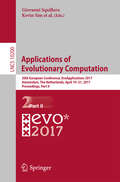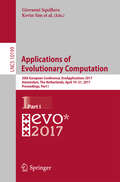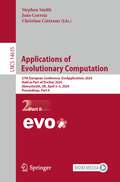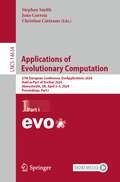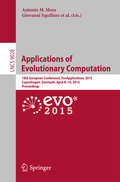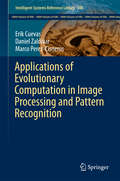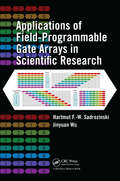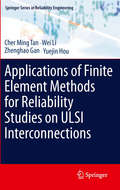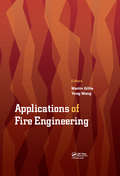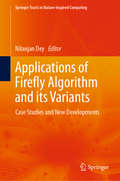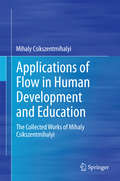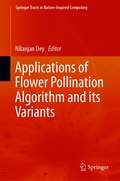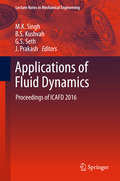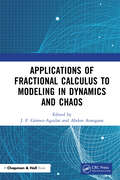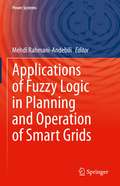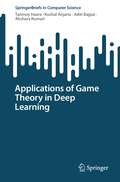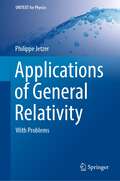- Table View
- List View
Applications of Evolutionary Computation: 21st European Conference, Evoapplications 2018, Parma, Italy, April 4-6, 2018, Proceedings (Lecture Notes in Computer Science #10784)
by Kevin Sim Paul KaufmannThis book constitutes the refereed conference proceedings of the 21st International Conference on the Applications of Evolutionary Computation, EvoApplications 2018, held in Parma, Italy, in April 2018, collocated with the Evo* 2018 events EuroGP, EvoCOP, and EvoMUSART. <P><P> The 59 revised full papers presented were carefully reviewed and selected from 84 submissions. EvoApplications 2018 combined research from 14 different domains: business analytics and finance (EvoBAFIN); computational biology (EvoBIO); communication networks and other parallel and distributed systems (EvoCOMNET); complex systems (EvoCOMPLEX); energy-related optimization (EvoENERGY); games and multi-agent systems (EvoGAMES); image analysis, signal processing and pattern recognition (EvoIASP); realworld industrial and commercial environments (EvoINDUSTRY); knowledge incorporation in evolutionary computation (EvoKNOW); continuous parameter optimization (EvoNUM); parallel architectures and distributed infrastructures (EvoPAR); evolutionary robotics (EvoROBOT); nature-inspired algorithms in software engineering and testing (EvoSET); and stochastic and dynamic environments (EvoSTOC).
Applications of Evolutionary Computation: 19th European Conference, Evoapplications 2016, Porto, Portugal, March 30 -- April 1, 2016, Proceedings, Part I (Lecture Notes in Computer Science #9597)
by Kevin Sim Giovanni SquilleroThis book constitutes the refereed conference proceedings of the 18th International Conference on the Applications of Evolutionary Computation, EvoApplications 2015, held in Copenhagen, Spain, in April 2015, colocated with the Evo 2015 events EuroGP, EvoCOP, and EvoMUSART. The 72 revised full papers presented were carefully reviewed and selected from 125 submissions. EvoApplications 2015 consisted of the following 13 tracks: EvoBIO (evolutionary computation, machine learning and data mining in computational biology), EvoCOMNET (nature-inspired techniques for telecommunication networks and other parallel and distributed systems), EvoCOMPLEX (evolutionary algorithms and complex systems), EvoENERGY (evolutionary computation in energy applications), EvoFIN (evolutionary and natural computation in finance and economics), EvoGAMES (bio-inspired algorithms in games), EvoIASP (evolutionary computation in image analysis, signal processing, and pattern recognition), EvoINDUSTRY (nature-inspired techniques in industrial settings), EvoNUM (bio-inspired algorithms for continuous parameter optimization), EvoPAR (parallel implementation of evolutionary algorithms), EvoRISK (computational intelligence for risk management, security and defence applications), EvoROBOT (evolutionary computation in robotics), and EvoSTOC (evolutionary algorithms in stochastic and dynamic environments).
Applications of Evolutionary Computation: 19th European Conference, Evoapplications 2016, Porto, Portugal, March 30 -- April 1, 2016, Proceedings, Part I (Lecture Notes in Computer Science #9597)
by Kevin Sim Giovanni SquilleroThis book constitutes the refereed conference proceedings of the 18th International Conference on the Applications of Evolutionary Computation, EvoApplications 2015, held in Copenhagen, Spain, in April 2015, colocated with the Evo 2015 events EuroGP, EvoCOP, and EvoMUSART. The 72 revised full papers presented were carefully reviewed and selected from 125 submissions. EvoApplications 2015 consisted of the following 13 tracks: EvoBIO (evolutionary computation, machine learning and data mining in computational biology), EvoCOMNET (nature-inspired techniques for telecommunication networks and other parallel and distributed systems), EvoCOMPLEX (evolutionary algorithms and complex systems), EvoENERGY (evolutionary computation in energy applications), EvoFIN (evolutionary and natural computation in finance and economics), EvoGAMES (bio-inspired algorithms in games), EvoIASP (evolutionary computation in image analysis, signal processing, and pattern recognition), EvoINDUSTRY (nature-inspired techniques in industrial settings), EvoNUM (bio-inspired algorithms for continuous parameter optimization), EvoPAR (parallel implementation of evolutionary algorithms), EvoRISK (computational intelligence for risk management, security and defence applications), EvoROBOT (evolutionary computation in robotics), and EvoSTOC (evolutionary algorithms in stochastic and dynamic environments).
Applications of Evolutionary Computation: 27th European Conference, EvoApplications 2024, Held as Part of EvoStar 2024, Aberystwyth, UK, April 3–5, 2024, Proceedings, Part II (Lecture Notes in Computer Science #14635)
by Stephen Smith João Correia Christian CintranoThe two-volume set LNCS 14634 and 14635 constitutes the refereed proceedings of the 27th European Conference on Applications of Evolutionary Computation, EvoApplications 2024, held as part of EvoStar 2024, in Aberystwyth, UK, April 3–5, 2024, and co-located with the EvoStar events, EvoCOP, EvoMUSART, and EuroGP.The 51 full papers presented in these proceedings were carefully reviewed and selected from 77 submissions. The papers have been organized in the following topical sections: applications of evolutionary computation; analysis of evolutionary computation methods: theory, empirics, and real-world applications; computational intelligence for sustainability; evolutionary computation in edge, fog, and cloud computing; evolutionary computation in image analysis, signal processing and pattern recognition; evolutionary machine learning; machine learning and AI in digital healthcare and personalized medicine; problem landscape analysis for efficient optimization; softcomputing applied to games; and surrogate-assisted evolutionary optimisation.
Applications of Evolutionary Computation: 27th European Conference, EvoApplications 2024, Held as Part of EvoStar 2024, Aberystwyth, UK, April 3–5, 2024, Proceedings, Part I (Lecture Notes in Computer Science #14634)
by Stephen Smith João Correia Christian CintranoThe two-volume set LNCS 14634 and 14635 constitutes the refereed proceedings of the 27th European Conference on Applications of Evolutionary Computation, EvoApplications 2024, held as part of EvoStar 2024, in Aberystwyth, UK, April 3–5, 2024, and co-located with the EvoStar events, EvoCOP, EvoMUSART, and EuroGP.The 51 full papers presented in these proceedings were carefully reviewed and selected from 77 submissions. The papers have been organized in the following topical sections: applications of evolutionary computation; analysis of evolutionary computation methods: theory, empirics, and real-world applications; computational intelligence for sustainability; evolutionary computation in edge, fog, and cloud computing; evolutionary computation in image analysis, signal processing and pattern recognition; evolutionary machine learning; machine learning and AI in digital healthcare and personalized medicine; problem landscape analysis for efficient optimization; softcomputing applied to games; and surrogate-assisted evolutionary optimisation.
Applications of Evolutionary Computation: 18th European Conference, EvoApplications 2015, Copenhagen, Denmark, April 8-10, 2015, Proceedings (Lecture Notes in Computer Science #9028)
by Giovanni Squillero Antonio M. MoraThis book constitutes the refereed conference proceedings of the 18th International Conference on the Applications of Evolutionary Computation, EvoApplications 2015, held in Copenhagen, Spain, in April 2015, colocated with the Evo 2015 events EuroGP, EvoCOP, and EvoMUSART. The 72 revised full papers presented were carefully reviewed and selected from 125 submissions. EvoApplications 2015 consisted of the following 13 tracks: EvoBIO (evolutionary computation, machine learning and data mining in computational biology), EvoCOMNET (nature-inspired techniques for telecommunication networks and other parallel and distributed systems), EvoCOMPLEX (evolutionary algorithms and complex systems), EvoENERGY (evolutionary computation in energy applications), EvoFIN (evolutionary and natural computation in finance and economics), EvoGAMES (bio-inspired algorithms in games), EvoIASP (evolutionary computation in image analysis, signal processing, and pattern recognition), EvoINDUSTRY (nature-inspired techniques in industrial settings), EvoNUM (bio-inspired algorithms for continuous parameter optimization), EvoPAR (parallel implementation of evolutionary algorithms), EvoRISK (computational intelligence for risk management, security and defence applications), EvoROBOT (evolutionary computation in robotics), and EvoSTOC (evolutionary algorithms in stochastic and dynamic environments).
Applications of Evolutionary Computation in Image Processing and Pattern Recognition (Intelligent Systems Reference Library #100)
by Erik Cuevas Daniel Zaldívar Marco Perez-CisnerosThis book presents the use of efficientEvolutionary Computation (EC) algorithms for solving diverse real-world imageprocessing and pattern recognition problems. It provides an overview of thedifferent aspects of evolutionary methods in order to enable the reader inreaching a global understanding of the field and, in conducting studies onspecific evolutionary techniques that are related to applications in imageprocessing and pattern recognition. It explains the basic ideas of the proposedapplications in a way that can also be understood by readers outside of thefield. Image processing and pattern recognition practitioners who are notevolutionary computation researchers will appreciate the discussed techniquesbeyond simple theoretical tools since they have been adapted to solvesignificant problems that commonly arise on such areas. On the other hand,members of the evolutionary computation community can learn the way in whichimage processing and pattern recognition problems can be translated into anoptimization task. The book has been structured so that each chapter can beread independently from the others. It can serve as reference book for studentsand researchers with basic knowledge in image processing and EC methods.
Applications of Existential Psychology: Introduction to Existential Psychology Volume 2
by Zoltán KőváryThe second in a two-part set, this volume offers a detailed examination of the application of existential psychology.This book begins by looking at the "conditio humana" – the most important topics of existential psychology, including anxiety, freedom, choices, authenticity, suffering and meaning, creativity, togetherness, time and death. It then moves through the practical application of existential psychology in the context of dreams, research, pathology and therapy. Examining key theories, models and research, the volume offers a fascinating overview of how the disciplines of art, philosophy, literature, science and theology contribute to a deeper understanding of personal self-knowledge and a person’s sense of purpose. This unique transdisciplinary approach demonstrates how readers can apply philosophical, historical and artistic aspects of existential psychology to their lives. The book concludes by considering the role of existential psychology in the present.Going beyond the questions of therapy and counselling that typically make up the study of existential psychology, the book offers the ultimate introduction for students and scholars of this fascinating and deeply rooted discipline. It may also interest professionals working in related fields.
Applications of FDG PET in Oncology: Best Clinical Practice
by Hirofumi Fujii Hiroyuki Nakamura Seiei YasudaThis book provides up-to-date guidance on the use of FDG PET to assess the biological activity and treatment response of a wide range of malignancies, including, for example, lung cancer, breast cancer, head and neck cancer, gastrointestinal cancer, and malignant lymphoma. In the era of precision medicine, numerous new anticancer agents, such as molecular targeted agents and immune checkpoint inhibitors, have been developed to improve outcomes in cancer patients. FDG PET plays a key role in evaluating the effects of these novel treatments because it can detect changes in the metabolic activity of tumors before any reduction in their size is visible on other imaging modalities. Accordingly, FDG PET is of prognostic as well as diagnostic value, and allows prompt changes in patient management. The book is written by expert clinicians from Japan, where the universal public health insurance system ensures that FDG PET is widely used in routine oncological practice and cancer screening. It represents an unrivaled and comprehensive resource that will be of value for all healthcare professionals in the field of clinical oncology.
Applications of Field-Programmable Gate Arrays in Scientific Research
by Hartmut F.-W. Sadrozinski Jinyuan WuFocusing on resource awareness in field-programmable gate array (FPGA) design, Applications of Field-Programmable Gate Arrays in Scientific Research covers the principle of FPGAs and their functionality. It explores a host of applications, ranging from small one-chip laboratory systems to large-scale applications in "big science." The book first de
Applications of Finite Element Methods for Reliability Studies on ULSI Interconnections (Springer Series in Reliability Engineering)
by Yuejin Hou Zhenghao Gan Cher Ming Tan Wei LiApplications of Finite Element Methods for Reliability Studies on ULSI Interconnections provides a detailed description of the application of finite element methods (FEMs) to the study of ULSI interconnect reliability. Over the past two decades the application of FEMs has become widespread and continues to lead to a much better understanding of reliability physics. To help readers cope with the increasing sophistication of FEMs' applications to interconnect reliability, Applications of Finite Element Methods for Reliability Studies on ULSI Interconnections will: introduce the principle of FEMs;review numerical modeling of ULSI interconnect reliability;describe the physical mechanism of ULSI interconnect reliability encountered in the electronics industry; anddiscuss in detail the use of FEMs to understand and improve ULSI interconnect reliability from both the physical and practical perspective, incorporating the Monte Carlo method.A full-scale review of the numerical modeling methodology used in the study of interconnect reliability highlights useful and noteworthy techniques that have been developed recently. Many illustrations are used throughout the book to improve the reader's understanding of the methodology and its verification. Actual experimental results and micrographs on ULSI interconnects are also included. Applications of Finite Element Methods for Reliability Studies on ULSI Interconnections is a good reference for researchers who are working on interconnect reliability modeling, as well as for those who want to know more about FEMs for reliability applications. It gives readers a thorough understanding of the applications of FEM to reliability modeling and an appreciation of the strengths and weaknesses of various numerical models for interconnect reliability.
Applications of Fire Engineering: Proceedings of the International Conference of Applications of Structural Fire Engineering (ASFE 2017), September 7-8, 2017, Manchester, United Kingdom
by Martin Gillie & Yong WangThis book holds the proceedings of the Conference on Applications of Structural Fire Engineering (ASFE 2017), held on September 7-8, 2017, in Manchester, UK. The ASFE’17 conference will be the next in a series (2009, 2011, 2013, 2015) of successful conferences that aim to bring together experts and specialists in design against fire from all over the world to share ideas and to acquire knowledge in the field of structural fire engineering. Practice in structural engineering increasingly accepts the benefits of performancebased approaches to the design of structures for fire resistance. This conference will focus on the application of design methods, both manual and computational, for structures to resist fire. Particularly relevant themes will be fire modelling, simulation of the heat transfer between fire and structures, and modelling of structural behaviour at elevated temperatures using numerical methods or software implementations of design codes.
Applications of Firefly Algorithm and its Variants: Case Studies and New Developments (Springer Tracts in Nature-Inspired Computing)
by Nilanjan DeyThe book discusses advantages of the firefly algorithm over other well-known metaheuristic algorithms in various engineering studies. The book provides a brief outline of various application-oriented problem solving methods, like economic emission load dispatch problem, designing a fully digital controlled reconfigurable switched beam nonconcentric ring array antenna, image segmentation, span minimization in permutation flow shop scheduling, multi-objective load dispatch problems, image compression, etc., using FA and its variants. It also covers the use of the firefly algorithm to select features, as research has shown that the firefly algorithm generates precise and optimal results in terms of time and optimality. In addition, the book also explores the potential of the firefly algorithm to provide a solution to traveling salesman problem, graph coloring problem, etc
Applications of Flow Cytometry in Stem Cell Research and Tissue Regeneration
by H. Krishnamurthy Satish Totey Awtar KrishanA much-needed primer on the use of laser flow cytometry for stem cell analysisLaser flow cytometry is a powerful tool for rapid analysis of cells for marker expression, cell cycle position, proliferation, and apoptosis. However, no resources specifically address the use of this methodology for the study of stem cells; this is especially important as stem cell analysis involves specialized methods and staining procedures based on specific characteristics such as marker expression, cell size, drug transport, and efflux of the stem cells.Now, this book reviews these procedures, discusses the science behind them, and provides real-world examples to illustrate the usefulness of the methods. It brings together world-class experts in pathology, biophysics, immunology, and stem cell research, who draw upon their extensive experience with the methods and show examples of good data to help guide researchers in the right direction.Chapter coverage includes:Stem cell analysis and sorting using side populationFlow cytometry in the study of proliferation and apoptosisStem cell biology and applicationIdentification and isolation of very small embryonic-like stem cells from murine and human specimensHematopoietic stem cells--issues in enumerationHuman embryonic stem cells: long-term culture and cardiovascular differentiationLimbal stem cells and corneal regenerationFlow cytometric sorting of spermatogonial stem cellsBreast cancer stem cellsStem cell marker expression in cells from body cavity fluidsThis book is an essential resource for all graduate students, practitioners in developing countries, libraries and book repositories of universities and research institutions, and individual researchers. It is also of interest to laboratories engaged in stem cell research and use of stem cells for tissue regeneration, and to any organization dealing in stem cell and tissue regeneration research.
Applications of Flow in Human Development and Education: The Collected Works of Mihaly Csikszentmihalyi
by Mihaly CsikszentmihalyiThe third volume of the collected works of Mihaly Csikszentmihalyi covers his work on the application of flow in areas that go beyond the field of leisure where the concept was first applied. Based on his personal experience with schooling and learning, as well as that of many others and contrary to what Cicero claimed, Csikszentmihalyi arrived at the conclusion that instead of taking pride in making the roots of knowledge as bitter as possible, we should try to make them sweeter. Just as flow became a popular and useful concept in voluntary activities, it could likewise be applied in education with the end result of young people being more likely to continue learning not just because they have to but because they want to. This volume brings together a number of articles in which Csikszentmihalyi develops ideas about how to make education and more generally the process of learning to live a good life, more enjoyable. Since theory is the mother of good practice, the first eleven chapters are devoted to theoretical reflections. Some are general and explore what it means to be a human being, what it means to be a person, when we look at life from the perspective of flow. Others are more narrowly focused on such topics as consumption, education, teaching and learning. They help laypeople reflect how they can arrange their lives in such a way as to leave a small ecological footprint while getting the most enjoyment. The second section of the volume contains a dozen empirical articles on similar topics They deal with the development of identity and self-worth; with the formation of goals and motivation; with loneliness and family life.
Applications of Flower Pollination Algorithm and its Variants (Springer Tracts in Nature-Inspired Computing)
by Nilanjan DeyThis book presents essential concepts of traditional Flower Pollination Algorithm (FPA) and its recent variants and also its application to find optimal solution for a variety of real-world engineering and medical problems. Swarm intelligence-based meta-heuristic algorithms are extensively implemented to solve a variety of real-world optimization problems due to its adaptability and robustness. FPA is one of the most successful swarm intelligence procedures developed in 2012 and extensively used in various optimization tasks for more than a decade. The mathematical model of FPA is quite straightforward and easy to understand and enhance, compared to other swarm approaches. Hence, FPA has attracted attention of researchers, who are working to find the optimal solutions in variety of domains, such as N-dimensional numerical optimization, constrained/unconstrained optimization, and linear/nonlinear optimization problems. Along with the traditional bat algorithm, the enhanced versions of FPA are also considered to solve a variety of optimization problems in science, engineering, and medical applications.
Applications of Fluid Dynamics: Proceedings of ICAFD 2016 (Lecture Notes in Mechanical Engineering)
by M. K. Singh B. S. Kushvah G. S. Seth J. PrakashThe book presents high-quality papers presented at 3rd International Conference on Applications of Fluid Dynamics (ICAFD 2016) organized by Department of Applied Mathematics, ISM Dhanbad, Jharkhand, India in association with Fluid Mechanics Group, University of Botswana, Botswana. The main theme of the Conference is "Sustainable Development in Africa and Asia in context of Fluid Dynamics and Modeling Approaches". The book is divided into seven sections covering all applications of fluid dynamics and their allied areas such as fluid dynamics, nanofluid, heat and mass transfer, numerical simulations and investigations of fluid dynamics, magnetohydrodynamics flow, solute transport modeling and water jet, and miscellaneous. The book is a good reference material for scientists and professionals working in the field of fluid dynamics.
Applications of Formal Philosophy: The Road Less Travelled (Logic, Argumentation & Reasoning #14)
by Rafał Urbaniak Gillman PayetteThis book features mathematical and formal philosophers' efforts to understand philosophical questions using mathematical techniques. It offers a collection of works from leading researchers in the area, who discuss some of the most fascinating ways formal methods are now being applied. It covers topics such as: the uses of probable and statistical reasoning, rational choice theory, reasoning in the environmental sciences, reasoning about laws and changes of rules, and reasoning about collective decision procedures as well as about action. Utilizing mathematical techniques has been very fruitful in the traditional domains of formal philosophy - logic, philosophy of mathematics and metaphysics - while formal philosophy is simultaneously branching out into other areas in philosophy and the social sciences. These areas particularly include ethics, political science, and the methodology of the natural and social sciences. Reasoning about legal rules, collective decision-making procedures, and rational choices are of interest to all those engaged in legal theory, political science and economics. Statistical reasoning is also of interest to political scientists and economists.
Applications of Fractional Calculus to Modeling in Dynamics and Chaos
by Gómez-Aguilar, J. F. Abdon AtanganaApplications of Fractional Calculus to Modeling in Dynamics and Chaos aims to present novel developments, trends, and applications of fractional-order derivatives with power law and Mittag-Leffler kernel in the areas of chemistry, mechanics, chaos, epidemiology, fluid mechanics, modeling, and engineering. Non-singular and non-local fractional-order derivatives have been applied in different chapters to describe complex problems. The book offers theory and practical applications for the solutions of real-life problems and will be of interest to graduate-level students, educators, researchers, and scientists interested in mathematical modeling and its diverse applications. Features Discusses real-world problems, theory, and applications Covers new developments and advances in the various areas of nonlinear dynamics, signal processing, and chaos Suitable to teach master’s and/or PhD-level graduate students, and can be used by researchers, from any field of the social, health, and physical sciences
Applications of Fracture Mechanics to Reinforced Concrete
by Alberto CarpinteriThis volume emphazises the most recent advances in fracture mechanics as specifically applied to steel bar reinforced concrete. Fracture mechanics has been applied to plain and fibre reinforced concrete with increasing success over recent years. This workshop extended these concepts to steel bar reinforced and pre-stressed concrete design. Particularly for high strength concrete, which is a very brittle material, and in the case of large structural members, the application of fracture mechanics appears to be very useful for improving the present design rules. The pre-eminent participants at the Turin workshop contributed extensive expert opinions in four selected areas for which a rational approach, using fracture mechanics, could introduce variations into the concrete design codes: size effects; anchorage and bond; minimum reinforcement for elements in flexure; and shear resistance. The 23 chapters logically address these themes and demonstrate the unique ability of fracture mechanics to capture all the experimentally observed characteristics. The book is primarily directed to the researchers in universities and institutions and will be of value to consultants and engineering companies.
Applications of Functional Foods and Nutraceuticals for Chronic Diseases: Volume I (Nutraceuticals)
by Syam Mohan Shima Abdollahi Yashwant V. PathakWhile disease is inevitable in humankind, the current century has been burdened with many chronic diseases, most of which are lifestyle mediated and, which in part can be controlled by consuming foods with specific functions. Functional foods are a special category of natural food or nutrient-derived pharmaceutical products containing beneficial biochemicals and phytochemicals beyond their basic nutritional functions. The first of two volumes, Applications of Functional Foods and Nutraceuticals for Chronic Diseases collects information on the association between functional and chronic diseases. The burden of escalating chronic diseases is discussed in the first chapter, and the remaining fourteen chapters summarize the effect of functional foods on a range of chronic diseases. Key Features: Discusses the clinical application of functional foods for the management of a wide range of chronic diseases Covers chronic diseases including Obesity, Arthritis, Cardiovascular Diseases, and Endocrinal and Hormonal Diseases, among others. Explores beneficial effects of nutraceuticals on chronic diseases Contributors hail from different geographical locations around the world and have many years of research and scholarly experience in functional foods, nutraceuticals, and biology. The world’s leading wellness centers for chronic diseases are using functional foods and nutraceuticals in their practice and discovering their useful applications, and this book is a great reference for practitioners, scientists, and clinicians in the management of chronic diseases.
Applications of Fuzzy Logic in Planning and Operation of Smart Grids (Power Systems)
by Mehdi Rahmani-AndebiliFuzzy logic has vast applications in power and electrical engineering. This collection is the first book to cover research advancements in the application of fuzzy logic in the planning and operation of smart grids. A global group of researchers and scholars present innovative approaches to fuzzy-based smart grid planning and operation, cover theoretical concepts and experimental results of the application of fuzzy-based techniques, and define and apply these techniques to deal with smart grid issues. Applications of Fuzzy Logic in Planning and Operation of Smart Grids is an ideal resource for researchers on the theory and application of fuzzy logic, practicing engineers working in electrical power engineering and power system planning, and post-graduates and students in advanced graduate-level courses.
Applications of Fuzzy Techniques: Proceedings of the 2022 Annual Conference of the North American Fuzzy Information Processing Society NAFIPS 2022 (Lecture Notes in Networks and Systems #500)
by Scott Dick Vladik Kreinovich Pawan LingrasThis book is of interest to practitioners, researchers and graduate students seeking to apply existing techniques, to learn about the state of the art, or to explore novel concepts, in the theory and application of fuzzy sets and logic. Human knowledge and judgement are essential in both designing technological systems and in evaluating their outcomes. However, humans think and communicate in imprecise concepts, not numbers. Fuzzy sets and logic are well-known, widely used approaches to bridging this gap, which have been studied for nearly 60 years. NAFIPS 2022 brought together researchers studying both the theoretical foundations of fuzzy logic and its application to real-world problems. Their work examined fuzzy solutions to problems as diverse as astronomy, chemical engineering, economics, energy engineering, health care, and transportation engineering. Many papers combined fuzzy logic with interval or probabilistic computing, neural networks, and genetic algorithms.
Applications of Game Theory in Deep Learning (SpringerBriefs in Computer Science)
by Tanmoy Hazra Kushal Anjaria Aditi Bajpai Akshara KumariThis book aims to unravel the complex tapestry that interweaves strategic decision-making models with the forefront of deep learning techniques. Applications of Game Theory in Deep Learning provides an extensive and insightful exploration of game theory in deep learning, diving deep into both the theoretical foundations and the real-world applications that showcase this intriguing intersection of fields. Starting with the essential foundations for comprehending both game theory and deep learning, delving into the individual significance of each field, the book culminates in a nuanced examination of Game Theory's pivotal role in augmenting and shaping the development of Deep Learning algorithms. By elucidating the theoretical underpinnings and practical applications of this synergistic relationship, we equip the reader with a comprehensive understanding of their combined potential. In our digital age, where algorithms and autonomous agents are becoming more common, the combination of game theory and deep learning has opened a new frontier of exploration. The combination of these two disciplines opens new and exciting avenues. We observe how artificial agents can think strategically, adapt to ever-shifting environments, and make decisions that are consistent with their goals and the dynamics of their surroundings. This book presents case studies, methodologies, and real-world applications.
Applications of General Relativity: With Problems (UNITEXT for Physics)
by Philippe JetzerThe aim of this textbook is to present in a comprehensive way several advanced topics of general relativity, including gravitational waves, tests of general relativity, time delay, spinors in curved spacetime, Hawking radiation, and geodetic precession to mention a few. These are all important topics in today's research activities from both a theoretical and experimental point of view. This textbook is designed for advanced undergraduate and graduate students to strengthen the knowledge acquired during the core courses on General Relativity. The author developed the book from a series of yearly lectures with the intention of offering a gentle introduction to the field. This book helps understanding the more specialized literature and can be used as a first reading to get quickly into the field when starting research. Chapter-end exercises complete the learning material to master key concepts.

